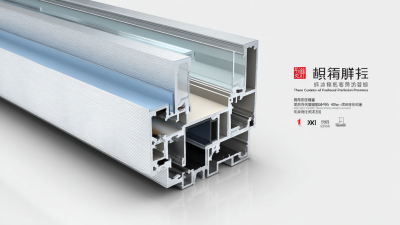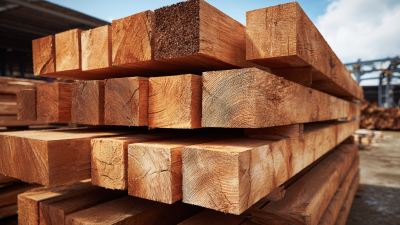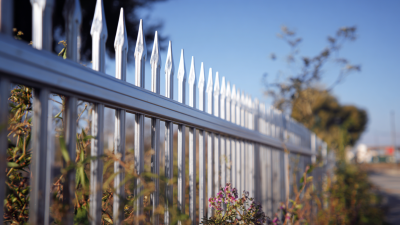The growing emphasis on sustainable building design has led to the increasing adoption of materials that not only enhance energy efficiency but also reduce carbon footprints. One such innovation is the use of Insulated Aluminum Profiles, which combine the lightweight properties of aluminum with thermal insulation solutions, significantly improving a building's performance. According to a report by the Aluminum Association, the construction sector accounts for nearly 40% of global energy consumption, and efficient materials like Insulated Aluminum Profiles can help mitigate this impact. By minimizing heat transfer and reducing reliance on heating and cooling systems, these profiles can lead to energy savings of up to 30% in commercial applications. Additionally, the durability and recyclable nature of aluminum contribute to a circular economy, fostering environmental sustainability in the construction industry. As architects and designers seek to meet both aesthetic and functional demands, Insulated Aluminum Profiles offer a compelling solution to drive sustainable practices forward.

Insulated aluminum profiles are becoming increasingly popular in energy-efficient architecture due to their impressive thermal performance and sustainability features. By integrating thermal insulation within the aluminum framework, these profiles significantly reduce heat transfer, leading to lower energy consumption for heating and cooling. This characteristic is crucial in designing buildings that adhere to stringent energy standards and aims to minimize environmental impact. The combination of insulation and aluminum not only enhances energy efficiency but also contributes to superior structural integrity, making these profiles a preferred choice for modern architectural designs.
Furthermore, insulated aluminum profiles offer versatility in aesthetic design without compromising functionality. Architects can leverage the sleek, contemporary look of aluminum while benefiting from its lightweight properties, making it easier to create innovative building shapes. The profiles can accommodate various finishes and colors, providing design flexibility that aligns with the project’s aesthetic vision. As a result, builders and architects can create environmentally friendly buildings that are not only energy-efficient but also visually appealing, further promoting the adoption of sustainable practices in construction.
Insulated aluminum profiles have emerged as a pivotal element in sustainable building design, characterized by their ability to enhance energy efficiency while maintaining structural integrity. One of the key characteristics of these profiles is their thermal insulation properties, which significantly reduce heat transfer between the interior and exterior environments. This feature not only optimizes energy consumption for heating and cooling but also contributes to a reduced carbon footprint, aligning with the growing emphasis on green building practices.

Moreover, insulated aluminum profiles are highly durable and resistant to corrosion, ensuring longevity and minimal maintenance requirements. Their lightweight nature allows for easier installation, reducing labor costs and time during construction. Additionally, these profiles are designed to enable greater design flexibility, allowing architects and builders to create aesthetically pleasing structures without compromising on energy efficiency. Through these characteristics, insulated aluminum profiles play a crucial role in fostering sustainable architecture, supporting initiatives aimed at reducing environmental impact while promoting innovative design solutions.
Insulated aluminum profiles are increasingly recognized for their advantages in sustainable building design, especially when compared to traditional building materials. Traditional materials often suffer from low energy efficiency and increased maintenance costs. In contrast, insulated aluminum profiles boast superior thermal performance, reducing heat transfer and minimizing reliance on heating systems. This results in lower energy consumption and a smaller carbon footprint, making them a compelling choice for eco-conscious builders.
**Tip:** When considering materials for your next project, evaluate the lifecycle assessment of each option. Insulated aluminum profiles tend to have a longer lifespan and require less energy to maintain, which can save costs over time.
Additionally, unlike traditional options, insulated aluminum can be customized to fit various designs and aesthetics, offering versatility without compromising sustainability. Their corrosion resistance and strength provide durable solutions that withstand harsh environmental conditions, further enhancing their appeal in modern architecture.
**Tip:** Take advantage of local suppliers who provide insulated aluminum profiles to reduce transportation emissions while supporting your community’s economy. Always check for certifications that confirm the sustainability of building materials before making an investment.
| Building Material | Thermal Insulation (R-value) | Energy Efficiency (%) | Durability (Years) | Recyclability (%) | Carbon Emissions (kg CO2/m²) |
|---|---|---|---|---|---|
| Insulated Aluminum Profiles | 5.0 | 30 | 50 | 90 | 3.2 |
| Traditional Aluminum | 2.5 | 15 | 40 | 70 | 4.5 |
| Wood | 3.8 | 25 | 30 | 60 | 5.0 |
| Brick | 1.8 | 10 | 75 | 30 | 6.0 |
Insulated aluminum profiles have emerged as a pivotal component in modern architectural solutions, significantly contributing to the sustainability of building designs. These profiles are characterized by their exceptional thermal performance, which helps in reducing energy consumption for heating and cooling. In residential and commercial buildings, the incorporation of insulated aluminum profiles not only enhances energy efficiency but also allows for larger expanses of glazing. This leads to increased natural light and improved aesthetics, creating more inviting spaces.
Moreover, insulated aluminum profiles are versatile and can be customized to fit various architectural styles. They are often used in facades, window frames, and curtain walls, offering design flexibility while maintaining structural integrity. Their lightweight nature combined with durability results in lower transportation costs and easier installation, making them ideal for a wide range of applications. As architects continue to prioritize environmental responsibility, the use of these profiles in sustainable building design is likely to grow, showcasing their essential role in the future of architecture.
The use of insulated aluminum profiles in sustainable building design is becoming increasingly significant as the global construction market is projected to grow from $181.63 billion in 2025 to $254.71 billion by 2034, reflecting a compound annual growth rate (CAGR) of 3.9%. This trend underscores the industry's shift towards materials that enhance energy efficiency and sustainability. Insulated aluminum profiles not only reduce energy consumption but also provide excellent thermal resistance and moisture control, which are crucial in achieving long-term sustainability goals.
Additionally, the insulation market is expected to expand notably, with projections indicating an increase from $70.1 billion in 2024 to $100.56 billion by 2031, growing at a CAGR of 6.45%. This growth is largely driven by the increasing demand for materials that improve building performance while minimizing environmental impact. Insulated aluminum profiles align perfectly with these market trends, offering long-lasting durability and superior insulation properties that contribute significantly to reducing operational energy use in buildings, thereby enhancing their overall sustainability impact.







